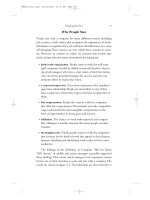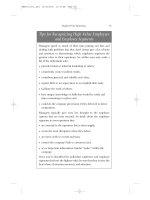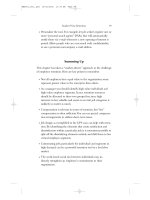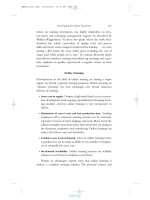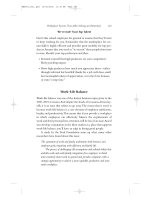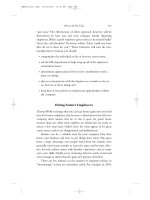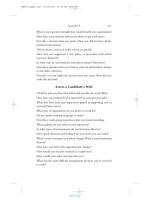Hiring and Keeping the Best People 15
Bạn đang xem bản rút gọn của tài liệu. Xem và tải ngay bản đầy đủ của tài liệu tại đây (91.9 KB, 8 trang )
•
Personalize the tool. For example, let job seekers register one or
more “personal search agents” (PSAs) that will automatically
notify them via e-mail whenever a new opening of interest is
posted.Allow people who are concerned with confidentiality
to use a personal, noncompany e-mail address.
Summing Up
This chapter has taken a “market-driven” approach to the challenge
of employee retention. Here are key points to remember:
•
Not all employees have equal value to the organization; some
represent greater value to the enterprise than others.
•
As a manager you should identify high-value individuals and
high-value employee segments. Scarce retention resources
should be allocated to these two groups first, since high
turnover in less valuable and easier-to-recruit job categories is
unlikely to matter as much.
•
Compensation is relevant in terms of retention, but “fair”
compensation is often sufficient.You can use special compensa-
tion arrangements to address short-term issues.
•
Job design, as exemplified in the UPS case, can help with reten-
tion. By identifying the elements that create satisfaction and
dissatisfaction within a particular job, it is sometimes possible to
split off the dissatisfying elements entirely and shift them to less
critical employee segments.
•
Customizing jobs, particularly for individuals and segments in
high demand, can be a powerful retention tool in a hot labor
market.
•
The work-based social ties between individuals may in-
directly strengthen an employee’s commitment to their
organization.
Market-Wise Retention 99
HBE001_ch4_.qxd 10/02/2002 11:34 AM Page 99
•
In some cases you can improve retention by deliberately
recruiting people who are in less demand, though this may
result in greater training costs.
•
By linking footloose employees with job opportunities
within the larger organization, it may be possible to reduce
organization-wide turnover rates.
100 Hiring and Keeping the Best People
HBE001_ch4_.qxd 10/02/2002 11:34 AM Page 100
Strategies for Training and Development
Developing the Talent
You Have
5
Key Topics Covered in This Chapter
•
Why employee training and career
development represent a dilemma for
employers
•
Formal and informal approaches to skill
training
•
Why training pays, with tips for reducing
costs through online learning
•
The retention benefits of career development
•
How mentors build bonds between talented
employees and their companies
•
What to do with C performers
HBE001_ch5_.qxd 10/02/2002 11:35 AM Page 101
T
hus far, we’ve discussed hiring techniques and vari-
ous strategies for employee retention. If implemented
effectively, these techniques and strategies can ensure the
human assets an enterprise needs to pursue its goals effectively.
Employee development is another way to fill open positions with
competent people. An alternative to recruiting, it prepares people
who are already a part of the organization to step into vacancies as
they occur.
Employee development has several important benefits for com-
panies.When properly managed it:
•
increases the value of the company’s human assets—which
are the prime assets of companies in a growing number of
industries;
•
assures that competent people will be ready and able to move
up as vacancies appear;
•
creates a pool of individuals who understand the company and
industry, and who are prepared to assume leadership as the
enterprise grows; and
•
contributes to effective retention.
That last point bears further elaboration. Substantial research
confirms that skill and career development (the two faces of employee
development) are near the top of the list of workplace features that
employees favor. As the Gallup Organization concluded in a broad-
HBE001_ch5_.qxd 10/02/2002 11:35 AM Page 102
based survey in 1999, “American workers who receive employer-
sponsored training are more satisfied with their jobs.”
1
And, as we’ve
learned, satisfied employees are more likely to stay with you.
The Development Dilemma
Many companies consider employee development a good invest-
ment. Employees become more knowledgeable and effective, which,
in turn, makes customers happier. Other companies, however, ques-
tion the value of employee development in the current era of high
workplace mobility.“Who,” they ask,“will reap the benefit of all this
expensive training and development if a) we are forced to lay these
people off, or b) they leave us for jobs elsewhere?” More pointedly,
they question,“Are we simply picking up the training tab for other
companies—perhaps our direct competitors?”
These questions underscore a dilemma for training and career
development. On the one hand, training investments make employ-
ees more valuable and more satisfied with the deal they are getting at
work. This is particularly true for technology workers and engineers
who recognize that their competencies erode over time. On the
other hand, the same investments that make people more valuable
make them more marketable and attractive to personnel poachers.
Many of America’s major brokerage firms, for example, have long
enjoyed a reputation as great trainers of retail stockbrokers. After
careful screening, they hire people with the right stuff for the busi-
ness, put them through three or four months of intensive sales and
investment training and licensing preparation, and then mainline
them into the day-to-day work of their nationwide branch offices.
Many small broker-dealers, meanwhile, spend little or nothing on
training. Instead, they lie in wait for the newly trained “registered
reps”to learn the ropes and build client accounts—and then they try
to recruit them. It is a way to acquire good people on the cheap.
The practice of poaching workers trained by others—or
“free riding”—deters some companies from investments in any
training that creates transferable (as opposed to “firm-specific”)
Developing the Talent You Have 103
HBE001_ch5_.qxd 10/02/2002 11:35 AM Page 103
